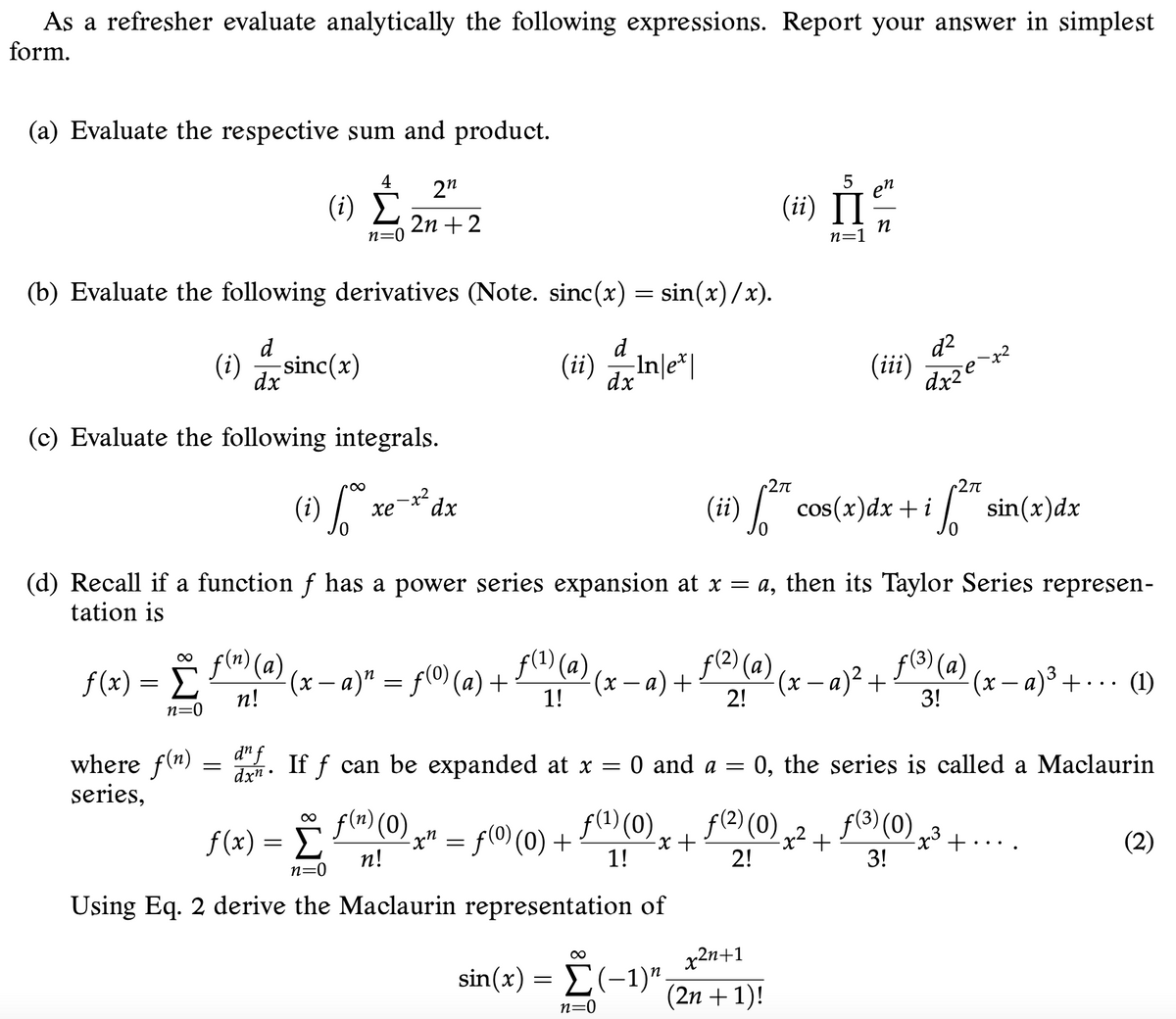Calculus: Early Transcendentals
8th Edition
ISBN:9781285741550
Author:James Stewart
Publisher:James Stewart
Chapter1: Functions And Models
Section: Chapter Questions
Problem 1RCC: (a) What is a function? What are its domain and range? (b) What is the graph of a function? (c) How...
Related questions
Question
I need help with this problem. Please show detailed steps.

Transcribed Image Text:As a refresher evaluate analytically the following expressions. Report your answer in simplest
form.
(a) Evaluate the respective sum and product.
4
5
(1) È„"
en
(ii) II
2n +2
n=0
n=1
(b) Evaluate the following derivatives (Note. sinc(x) = sin(x)/x).
d2
(ii)
d
(#) Inle"|
d
Inle*|
(i)
sinc(x)
dx
dx
(c) Evaluate the following integrals.
27
* dx
хе
(ii) *
cos(x)dx +i sin(x)dx
(i)
(d) Recall if a function f has a power series expansion at x = a, then its Taylor Series represen-
tation is
f(1) (a)
f(2) (a)
f(3) (a)
00
f (x) = f (a)
(x – a)" = f(O) (a) +
(x – a) + (@) (x – a)² +
(x– a)³ + · · · (1)
3!
n!
1!
2!
n=0
d" f
where f(n)
series,
dxn •
If f can be expanded at x = 0 and a =
0, the series is called a Maclaurin
f (x) = (0)g" = f(0)(0) +
f(1) (0)
f(2) (0) ,2 +
f(3) (0)3
-x +
1!
+.
(2)
..
n!
2!
3!
n=0
Using Eq. 2 derive the Maclaurin representation of
x2n+1
sin(x) = E(-1)".
(2n + 1)!
n=0
Expert Solution
This question has been solved!
Explore an expertly crafted, step-by-step solution for a thorough understanding of key concepts.
This is a popular solution!
Trending now
This is a popular solution!
Step by step
Solved in 2 steps

Recommended textbooks for you

Calculus: Early Transcendentals
Calculus
ISBN:
9781285741550
Author:
James Stewart
Publisher:
Cengage Learning

Thomas' Calculus (14th Edition)
Calculus
ISBN:
9780134438986
Author:
Joel R. Hass, Christopher E. Heil, Maurice D. Weir
Publisher:
PEARSON

Calculus: Early Transcendentals (3rd Edition)
Calculus
ISBN:
9780134763644
Author:
William L. Briggs, Lyle Cochran, Bernard Gillett, Eric Schulz
Publisher:
PEARSON

Calculus: Early Transcendentals
Calculus
ISBN:
9781285741550
Author:
James Stewart
Publisher:
Cengage Learning

Thomas' Calculus (14th Edition)
Calculus
ISBN:
9780134438986
Author:
Joel R. Hass, Christopher E. Heil, Maurice D. Weir
Publisher:
PEARSON

Calculus: Early Transcendentals (3rd Edition)
Calculus
ISBN:
9780134763644
Author:
William L. Briggs, Lyle Cochran, Bernard Gillett, Eric Schulz
Publisher:
PEARSON

Calculus: Early Transcendentals
Calculus
ISBN:
9781319050740
Author:
Jon Rogawski, Colin Adams, Robert Franzosa
Publisher:
W. H. Freeman


Calculus: Early Transcendental Functions
Calculus
ISBN:
9781337552516
Author:
Ron Larson, Bruce H. Edwards
Publisher:
Cengage Learning